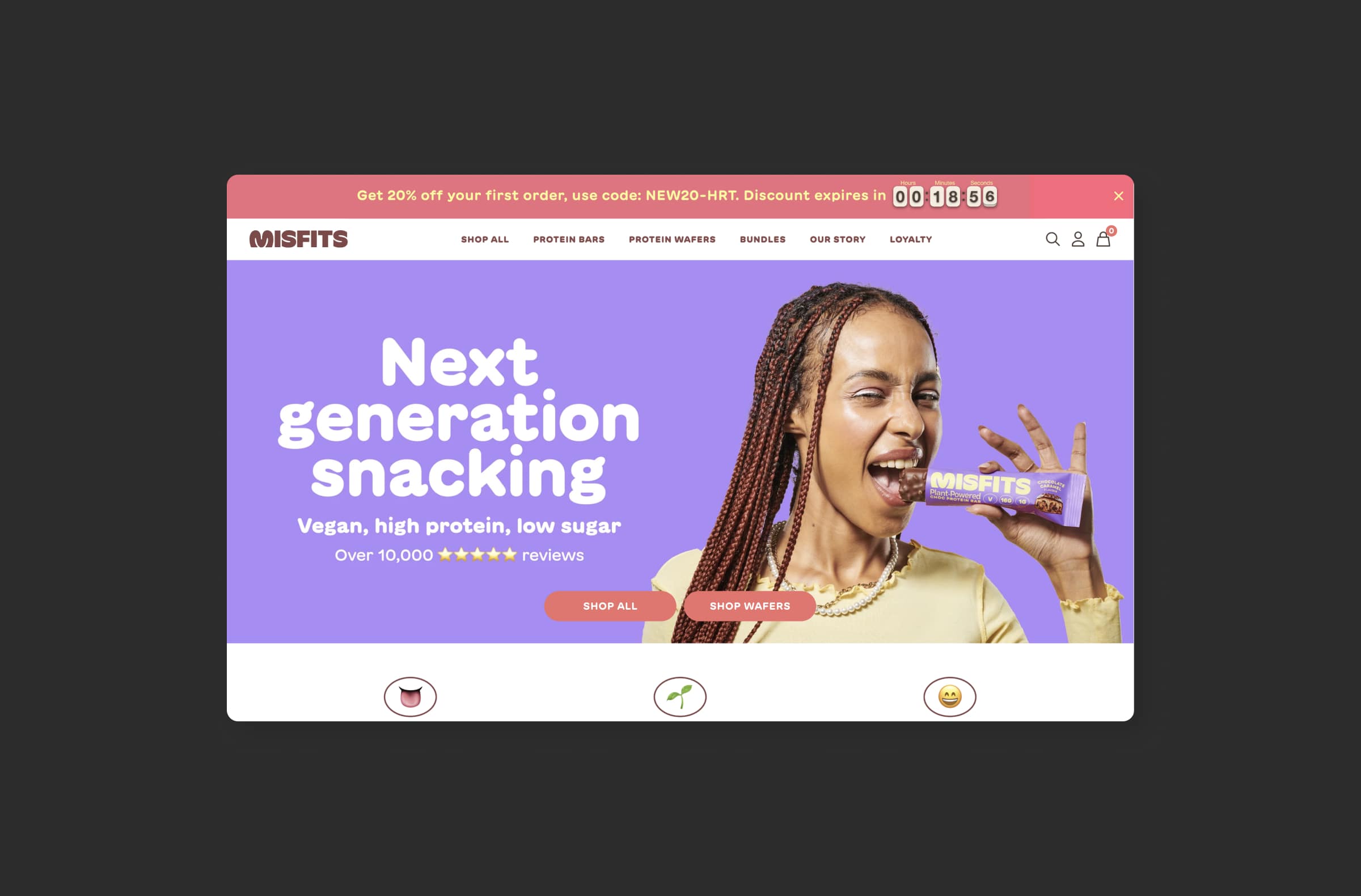Creating a sense of urgency is a powerful strategy to boost conversions on your eCommerce website. But urgency isn’t just about triggering a single action. It’s about accelerating the customer’s journey from awareness through consideration to purchase and beyond. With peak season just around the corner, we’ve gathered eight effective ways (complete with examples) to create urgency and support journey-led growth across your site.
1. Limited-time offers.
Promote time-bound deals and discounts, such as flash sales, daily deals, or weekend specials. Implement countdown timers on product pages or at checkout to show how much time remains for a specific offer or discount to expire. In doing so, you not only encourage immediate action but also guide the user further along their journey from browsing to decision-making. For example, the high-protein, healthy-snacking brand Misfits has added a countdown timer at the top of the site with “Discount expires in…” messaging (see example below).

2. Delivery countdown.
Promote limited free delivery periods, or for customers who want the product quickly, implementing a delivery countdown is a great tactic to encourage conversion and acts as a visual reminder of how long they have to make the purchase. Again, this isn’t just about the purchase moment. It supports the journey by reducing friction and reinforcing the value of progress. For example, Rave Coffee has added messaging like “Order within 2 hours and 3 minutes to get delivery in the next 1-2 days” with a vibrating alarm-clock design flourish.

3. Low stock alerts.
Display the number of items left in stock for a particular product, signalling scarcity and encouraging customers to act quickly before the item is sold out. Use messages like “Only 1 left”, as premium fashion retailer RIXO has done, to create urgency. This helps guide the customer through the journey by prompting a decision when they’re already engaged and almost ready to buy.

4. Fear of missing out (FOMO) messaging.
Craft persuasive copy that conveys the idea that missing out on the current offer would be a regrettable decision. Use phrases like “Don’t miss out!” or “Limited quantities available”, or, as the example from ASOS shows, “Selling fast.” FOMO is especially effective because it taps into emotion. This helps move a customer from consideration to action while still aligning with the broader journey concept: you’ve considered, now act.

5. Exclusive VIP offers.
Offer special discounts or early access to products to your loyal customers or email list members. This makes customers feel valued and motivated to take advantage of the exclusive opportunity. For example, the brand Rat & Boa has created a members-only “access-all-areas” pass that provides unique rewards and bespoke benefits. Within a journey-led growth mindset, this approach stretches beyond conversion: it nurtures loyalty and repeat behaviour, helping customers move from “buy once” to “buy again”.

6. Abandoned cart reminders.
Send automated emails to customers who have items in their carts but haven’t completed their purchases. Include a reminder of the urgency of the items and, if possible, offer a small discount to entice them to finalise their purchase. As shown by retailers Casper and ASOS, abandoned cart messaging can be fun and friendly, too. This strategy directly supports the journey by re-engaging users who stalled at the “decision” step and helping them complete the progression toward conversion.

7. Social proof.
Display real-time notifications of recent purchases made by other customers. This technique leverages the principle of social proof, showing potential buyers that others are actively purchasing a particular product. This can accelerate movement from consideration into action. For example, the global online marketplace Etsy has utilised this with the “In 15 baskets” message next to the price. In a journey-led framework, social proof helps validate the choice and advances the customer’s confidence level to move forward.

8. Coming soon.
By generating anticipation among customers for an upcoming product release, you gradually heighten their curiosity. As the product’s availability in your store approaches, this curiosity turns into a sense of urgency. For example, premium fashion retailer WYSE London employed a simple “coming soon” message on graphics. From a journey perspective, this technique adds a “pre-consideration” phase: building interest before the decision moment and priming the user to act once the window opens.

Summary: a clear path to increased conversions.
With these eight ways to create urgency and increase conversions, you’ve now got a journey-led path to peak season success. Remember, the goal is not just to prompt a purchase, but to support a seamless journey from discovering your brand, through engagement, decision, conversion and onward into loyalty and repeat business.
Of course, the urgency you create must be genuine and not misleading. And just as importantly, you must ensure that your website’s user experience is optimised for easy navigation, quick loading times, and a seamless checkout process to support the whole customer journey effectively.
By strategically implementing these urgency-inducing techniques (while keeping the broader journey in mind), you can not only increase conversions on your eCommerce website but also drive higher lifetime value and sustained growth for your brand.
Want help driving growth on your eCommerce store?
We’re a Shopify Premier Partner agency helping brands grow through journey-led strategy, elevated experiences, and measurable results. Explore our services and browse our work, or get in touch to discuss your requirements. We would love to help you build a growth-led journey from first touch to repeat purchase.






)

